About Walking On The Beach
This guide explains the physical and mental benefits of beach walking for older adults. It covers physical advantages like increased muscle strength and improved balance, mental well-being from the "blue space" effect, and safety advice on footwear, terrain, and medical considerations. Use the links below to jump to the section that interests you most.
The Centers for Disease Control and Prevention (CDC) recommends that adults aged 65 and older get at least 150 minutes of moderate-intensity aerobic activity, like brisk walking, each week[1, 2]. This should be supplemented with at least two days of muscle-strengthening activities and exercises to improve balance[3, 4]. The National Institute on Aging (NIA) also states that regular physical activity helps maintain independence, reduces the risk of chronic diseases such as heart disease and diabetes, and prevents falls[5, 6]. Beach walking can help meet these guidelines by combining aerobic, muscle-strengthening, and balance-challenging exercise.
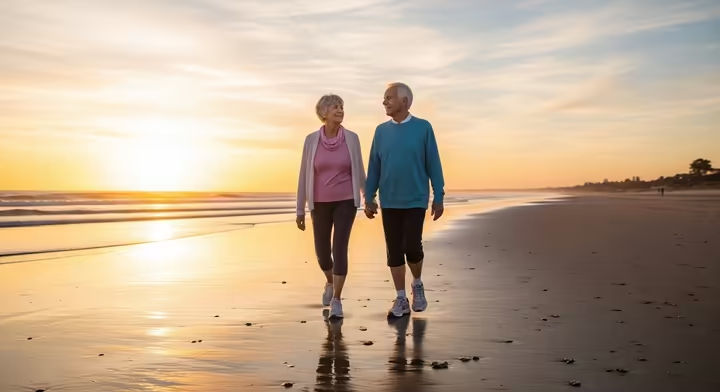
Part I: Physical Benefits of Beach Walking
Walking on sand requires more effort than walking on pavement. The soft, shifting surface makes the body work harder, which provides additional physical benefits.
Increased Muscle Strength and Calorie Burn
The instability and resistance of sand force your body to work harder with every step. When your foot sinks into soft sand, your muscles must generate more power to push off, turning the walk into a form of resistance training[7]. This process strengthens the lower body, including the calves, quadriceps, and glutes, and engages the core muscles to maintain stability on the unsteady surface[8, 9, 10].
This increased muscular effort leads to a higher calorie burn. Research published in the European Journal of Applied Physiology indicates that walking on sand requires 2.1 to 2.7 times more energy than walking on a hard surface at the same speed[10, 11, 12]. Other analyses suggest the calorie burn is 30% to 50% greater than on grass or pavement[13]. This can have measurable results; a 2020 study found that over time, participants who walked on sand experienced a greater reduction in waist circumference compared to those who walked on pavement (5.3 cm vs. 3 cm, respectively)[9].
The increased physical demand also benefits cardiovascular health. The effort required to walk on sand elevates the heart rate, providing a more intense cardiovascular workout than walking on flat ground[13, 15]. The American Heart Association states, "Research has shown that walking can have a significant impact on your health by lowering your chances of heart disease"[16]. By increasing the intensity, beach walking helps seniors strengthen their heart and improve circulation.
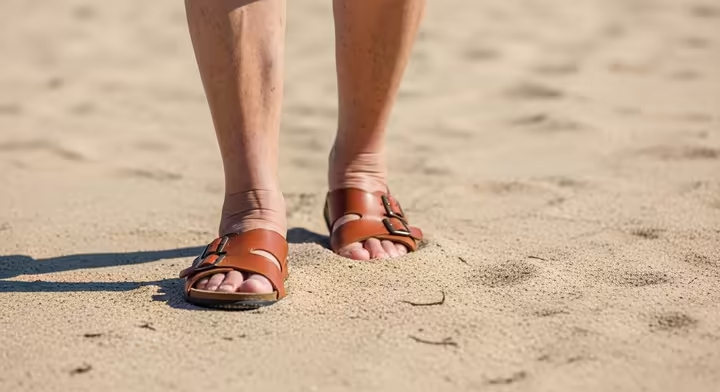
Reduced Joint Impact and Arthritis Pain
For many seniors, especially those with arthritis, high-impact exercise can cause pain. The soft nature of sand provides natural cushioning that absorbs impact and reduces the ground reaction forces (GRF) that can aggravate joints[9, 17]. This shock-absorbing quality lessens the stress on the knees, hips, and back, which are common sites of arthritic pain[17].
Similarly, studies show that the buoyancy of water dramatically reduces GRF, making it an excellent therapeutic environment for painful joints[18, 19]. Sand provides a comparable cushioning effect, making it a safer alternative to pavement for many individuals with joint pain[19, 20].
The Arthritis Foundation endorses walking, stating, "For people of any age with arthritis, walking is especially good medicine. It strengthens muscles, which helps shift pressure from joints and reduce pain"[21]. The foundation suggests a walk at the beach as a recommended "scenic route," acknowledging its benefits[21].
However, the wrong conditions can worsen joint pain. Walking on soft, uneven sand or on a steep slope can increase strain on the knees and back by forcing the joints into unnatural angles[17]. For many with arthritis, walking on the flat, firm, wet sand near the water's edge is most comfortable. In contrast, walking on dry, loose, and steeply sloped sand can be detrimental and should be avoided by those with significant joint instability or pain.
Improved Balance and Fall Prevention
Falls are a significant threat to the health and independence of older adults. Beach walking can help prevent falls by improving the body's balance systems.
This effect is due to proprioception and reactive balance. Proprioception is the body's internal sense of its position and motion[10, 22]. Walking on an unstable surface like sand constantly challenges this sense, forcing the nervous system to become more responsive[22]. This is a form of Reactive Balance Training (RBT), which improves the body's automatic reactions to unexpected trips or slips[23]. Since most falls are caused by such events, training these reactions is critical. Systematic reviews have found that RBT can reduce fall rates by 46% to 48%[23].
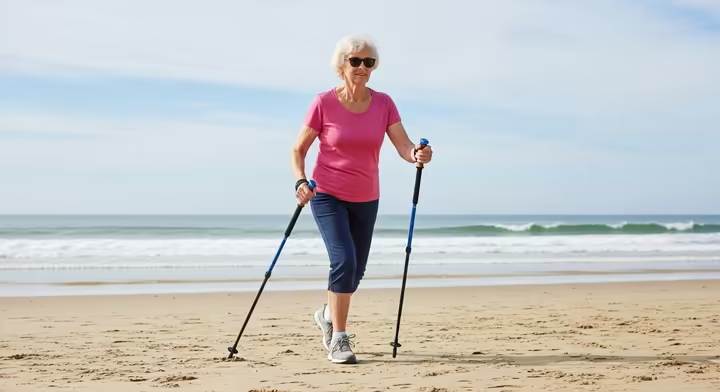
Walking on sand is a natural form of RBT. The shifting surface forces the small, stabilizing muscles in the feet and ankles to work constantly, strengthening them over time[7]. Enhanced ankle strength and stability are critical for fall prevention[24]. While static exercises like single-leg stands are beneficial, they do not fully prepare the body for unpredictable environments. A 2014 study in Japan found that a supervised walking program was more effective at preventing falls among community-dwelling older adults than a dedicated balance and strength training program[25]. This suggests that the dynamic challenge of walking in a beach environment is highly effective for improving the systems that prevent falls.
Increased Bone Density through Exercise and Vitamin D
Osteoporosis, a condition of weak and brittle bones, is a major health concern for seniors. Beach walking helps build and maintain bone density through a combination of low-impact weight-bearing exercise, muscular resistance, and Vitamin D from sun exposure.
First, walking is a weight-bearing exercise. Each step signals the skeleton to grow stronger and denser[26, 27]. A study of postmenopausal women revealed that those who walked more than 7.5 miles per week had significantly higher whole-body bone density than women who walked less than one mile per week, and that walking was effective in slowing the rate of bone loss from the legs[28].
Second, the resistance of sand strengthens the muscles of the legs and core. Strong muscles support the skeleton, improving stability and reducing stress on bones.
Third, beach walking provides an opportunity for sun exposure, which allows the body to produce Vitamin D[8]. This vitamin is essential for bone health, as it enables the body to absorb calcium and deposit it into the bone matrix[15]. Without sufficient Vitamin D, calcium cannot be used effectively.
A 2022 study confirmed this combination of benefits. Researchers studied elderly subjects with osteopenia and found that a daytime walking group (exercise plus sun exposure) experienced significantly greater improvements in lumbar bone mineral density than a night-time walking group (exercise only) or a sun-exposure-only group[29]. This demonstrates that the combination of weight-bearing activity and sun-derived Vitamin D is more effective than either factor alone, making daytime beach walking an efficient activity for osteoporosis management.
Part II: Mental and Social Benefits
Walking on a beach also offers mental, cognitive, and social benefits. The coastal environment can have a positive impact on well-being.
The "Blue Space" Effect: Reduced Stress and Improved Mood
Researchers use the term "Blue Space" to describe environments with visible bodies of water. A growing body of evidence confirms the health benefits of these spaces. A 2021 systematic review and meta-analysis found that contact with blue space was significantly associated with stress reduction and improved mood[30]. This supports earlier findings that spending time in nature helps lower levels of cortisol, the body's primary stress hormone[8].
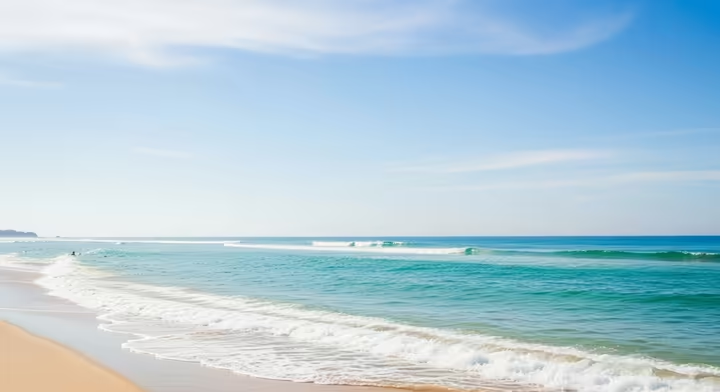
This effect may be particularly strong for older adults. A systematic review from 2024, focusing on the elderly, concluded that both proximity to and the quantity of blue spaces were positively associated with better mental health outcomes[31]. Further supporting this, a study from Washington State University found that a 10% increase in access to forests or water bodies within a person's residential ZIP code was associated with reduced rates of serious psychological distress among older adults[32]. The coastal environment actively contributes to these health benefits.
Cognitive Benefits and Mindfulness
The beach's sights, sounds, and smells encourage mindfulness and cognitive activity. Researchers describe being by the sea as a "multisensory, embodied experience" that anchors individuals in the present moment[31]. The sound of the waves, the scent of salt, the feeling of the breeze, and the sensation of sand and water all work to draw attention away from internal anxieties[9, 33].
This sensory immersion is a natural form of mindfulness, which has been shown to reduce the repetitive negative thinking that can contribute to anxiety and depression[10]. This state of mental restoration and reduced stress can also improve cognitive function and sleep quality. By providing a calming, engaging environment, nature-based exercise like beach walking can help regulate circadian rhythms, leading to more restful sleep and improved mental clarity[34, 35].
Social Benefits: Building Connections to Combat Isolation
Social isolation is a critical public health issue for older adults. Group walking is an effective way to combat it, and the beach is an excellent place for social activity.
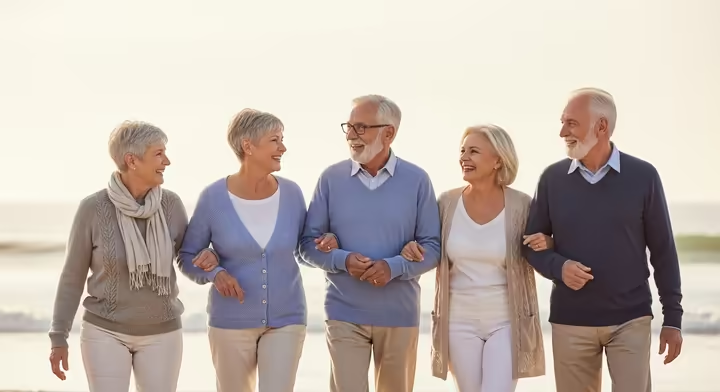
Walking groups offer a natural opportunity to meet people and build a supportive social network[36, 37]. The shared activity creates a sense of community and purpose[36, 38]. Furthermore, walking with others provides motivation, accountability, and a sense of safety, making it easier to maintain an exercise routine[39, 40].
The beach environment itself may encourage social interaction. Research into blue spaces suggests they can be better at promoting social interactions than parks[30, 41]. A 2024 systematic review on older adults and blue spaces identified "opportunities for social interactions" as a key benefit of coastal environments[31]. A beach walking group combines the benefits of group exercise with the socially conducive properties of a coastal setting, making it an effective way to reduce senior isolation.
Part III: Safety and Practical Advice
To walk on the beach safely, it is important to be prepared. This section provides practical safety guidelines.
Safety Checklist for Seniors
Before you head out for your walk, use this checklist to ensure a safe experience:
- Check the Forecast: Look at the weather forecast and tide charts to avoid extreme heat, storms, or unexpectedly high tides.
- Inform Someone: Let a friend or family member know your planned route and your expected return time.
- Hydrate: Pack a bottle of water and drink regularly, even if you don't feel thirsty. Dehydration is a greater risk for older adults[42, 43].
- Protect Your Skin: Apply a broad-spectrum sunscreen with SPF 30 or higher to all exposed skin at least 15-30 minutes before you go out, even on cloudy days[8, 43].
- Cover Up: Wear a wide-brimmed hat to protect your face and neck, and UV-protective sunglasses to shield your eyes[43, 44].
- Stay Connected and Prepared: Carry a fully charged mobile phone for emergencies. If you use medications for conditions like angina, be sure to have them with you[45].
- Assess the Terrain: Before you start, scan the beach for potential hazards such as steep slopes, hidden rocks, or debris.
Footwear: The Barefoot vs. Shoe Debate
Walking barefoot on sand is appealing, but for seniors, the decision requires careful consideration of the risks and benefits. For healthy individuals with no underlying foot conditions, walking barefoot can help strengthen foot muscles, improve proprioceptive feedback, and promote a natural gait[10, 34]. The sand can also act as a gentle exfoliant[9].
However, the risks are significant. The most immediate danger is from cuts or puncture wounds from sharp shells, glass, or other hidden debris[8, 43]. Additionally, walking long distances without arch support can lead to strain in the feet, ankles, and legs[8].
For certain individuals, walking barefoot is not recommended. This is especially true for anyone with diabetes or peripheral neuropathy . Nerve damage can diminish sensation in the feet, meaning a small cut or blister might go unnoticed. Combined with often-impaired circulation, a minor injury can fail to heal properly, potentially leading to a severe infection or foot ulcer[34]. Similarly, individuals with plantar fasciitis may find that walking on an unsupportive surface like sand aggravates their heel pain[34]. For these groups, wearing appropriate, supportive footwear is a critical safety measure.
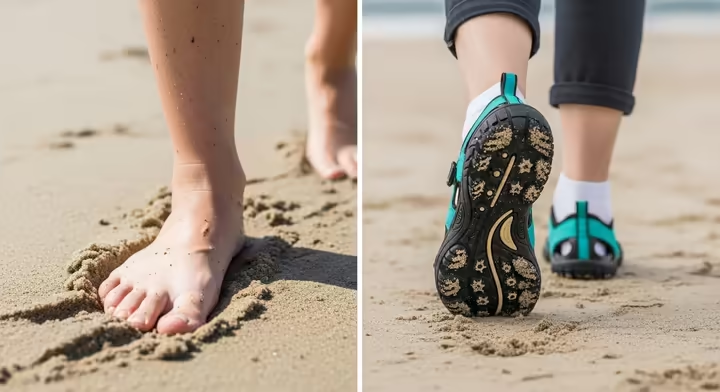
Gear Guide: Best Footwear & Walking Poles
The right gear improves comfort and safety on the beach.
- Shoe Features: Prioritize features that promote good foot health. Look for the American Podiatric Medical Association (APMA) Seal of Acceptance , which indicates a product has been reviewed by podiatrists and found to be beneficial for foot health[46, 47]. Key features include excellent arch support, a stable and non-slip sole, a wide toe box, and adjustable straps for a secure fit[48, 49].
- Supportive Sandals: A good pair of supportive sandals can be an excellent choice. Brands such as Vionic, Teva, Naot, and Birkenstock offer many models that carry the APMA seal and feature robust arch support, cushioned footbeds, and secure straps that prevent your foot from sliding[50, 51, 52]. Ensure any sandal has a back strap to prevent toes from over-gripping, which can lead to foot strain[49].
- Water Shoes: For those who plan to walk at the water's edge, water shoes are ideal. The best models are made from quick-drying materials like neoprene and mesh, feature a high-grip rubber outsole for traction on wet surfaces, and provide adequate midsole cushioning and support[53, 54].
- Walking Poles: Using a pair of walking poles is highly recommended for seniors walking on the beach. They provide two additional points of contact with the ground, significantly enhancing stability, reducing the risk of falls, and lessening the load on the hips, knees, and ankles, especially on slopes or uneven sand[22, 55].
Understanding the Terrain: Sand Types, Slopes, and Stability
By learning to "read" the terrain, you can adjust the intensity of your walk and choose the safest path for your fitness level. Different types of sand offer different levels of resistance, allowing you to gradually increase the difficulty of your walk.
The wet, packed sand near the water's edge is the firmest and most stable surface[8, 56]. This is the ideal starting point for beginners, individuals with balance concerns, or those with joint pain[9, 42]. In contrast, the dry, loose sand further up the beach is more unstable and provides significantly more resistance[7, 9]. This is a more advanced workout for building greater strength. A good way to progress is to start on the firm sand and, as you grow stronger, incorporate short intervals on the softer sand.
A common hazard of beach walking is the slope . Most beaches are canted towards the water, and walking along this incline for a prolonged period places asymmetrical stress on the body. This can strain the ankles, knees, hips, and lower back[17]. To avoid this, frequently turn around and walk back in the opposite direction to work both sides of your body evenly[8].
Critical Health Considerations: When to Consult Your Doctor
While beach walking is a safe activity for most older adults, certain pre-existing conditions require specific precautions or may make this activity inadvisable.
| Condition | Key Risks | Recommended Precautions / Contraindications |
|---|---|---|
| Arthritis (Osteoarthritis) | Aggravation of joint pain from unstable surfaces or slopes. | Precautions: Start on flat, firm sand. Wear supportive, cushioned footwear. Use walking poles for stability. Avoid soft, steeply sloped sand[17, 21]. |
| Diabetes / Peripheral Neuropathy | High risk of undetected foot injury (cuts, blisters) leading to severe infection or ulcers due to lack of sensation. | Contraindication for Barefoot Walking: Never walk barefoot. Always wear protective, well-fitting shoes and inspect feet thoroughly after every walk[34]. |
| Recent Joint Replacement (<6 months) | Increased stress on the new joint, potential for implant loosening, and risk of falls can hinder recovery. | Contraindication (Early Recovery): Avoid walking on uneven surfaces like sand until cleared by your orthopedic surgeon. Long-term: Favor firm, packed sand and use walking poles[42, 57, 58]. |
| Stable Heart Condition | Overexertion leading to symptoms like chest pain or shortness of breath. | Precautions: Consult your cardiologist. Start slowly on flat, firm sand. Monitor for symptoms and rest as needed. Always carry prescribed medication (e.g., nitroglycerin)[45, 59]. |
| Unstable Heart Failure | High risk of decompensation due to increased cardiac demand. | Absolute Contraindication: Exercise is not recommended for those with unstable or worsening heart failure symptoms. This includes worsening shortness of breath or recent weight gain[60]. |
| Severe Osteoporosis | High risk of fracture from a fall on an unpredictable, uneven surface. | Precautions: Prioritize stability above all. Walk only on the flattest, firmest sand. Always use walking poles. Walk with a companion. Avoid the beach on windy days or in crowded conditions[61, 62]. |
A Note on "Earthing": Separating Hypothesis from Fact
In discussions about walking barefoot, the concept of "grounding" or "earthing" often arises. The hypothesis is that direct physical contact with the Earth's surface allows for a transfer of free electrons from the ground into the body. Proponents suggest these electrons act as antioxidants, neutralizing free radicals that contribute to inflammation[35].
Some research, much of it from advocates of the theory, has reported potential benefits, including reduced inflammation and pain, improved sleep, and a reduction in blood viscosity[35, 63, 64]. A 2015 review in the Journal of Inflammation Research stated, "Multi-disciplinary research has revealed that electrically conductive contact of the human body with the surface of the Earth (grounding or earthing) produces intriguing effects on physiology and health... Such effects relate to inflammation, immune responses, wound healing, and prevention and treatment of chronic inflammatory and autoimmune diseases"[64].
It is important, however, to approach these claims with caution. "Earthing" is not a medically-accepted therapy, and some studies have been conducted by individuals with a commercial interest in grounding products[65]. The safest approach is to view any potential benefits from earthing as a bonus to the well-established benefits of a beach walk, rather than the primary reason to do it.
Your First Week: A 20-Minute Beginner's Beach Walk Routine
This routine helps you start safely and build strength gradually. Always listen to your body and rest if you feel pain or excessive fatigue.
- Warm-up (5 minutes on solid ground): Before you step onto the sand, prepare your muscles and joints. Perform 10-15 ankle rolls in each direction, hold a gentle calf stretch for 30 seconds per leg, and do a few standing quadriceps stretches[8].
- Main Walk (10 minutes): Begin walking at a comfortable, conversational pace on the firm, wet sand near the water's edge. Focus on maintaining good posture—head up, shoulders back—and lifting your legs with each step rather than shuffling[66, 67].
- Challenge Interval (optional, 2 minutes): If you feel steady, try walking on the edge where the firm sand meets the softer sand for 30 seconds, then return to the firm sand for 30 seconds. Repeat this cycle twice.
- Cool-down (3 minutes on firm sand): Gradually slow your pace for the final few minutes. Finish with another round of gentle stretches, holding each for at least 30 seconds to improve flexibility[59, 68].
- How to Progress: As you feel stronger, add one to two minutes to your main walk each session. Once you can comfortably walk for 20-30 minutes, you can increase the duration of your challenge intervals on the softer sand.
Conclusion
Walking on the beach offers a combination of physical, mental, and social benefits for older adults. It builds strength, improves balance, and supports bone health while reducing stress and providing opportunities for social connection.
To benefit safely, it is important to understand your health limitations, consult a doctor, use proper footwear, and be aware of beach conditions like sand type and slope. By following the safety guidelines in this guide, you can enjoy the benefits of walking on the beach.
Works cited
- Moving Matters for Older Adults - CDC, https://www.cdc.gov/moving-matters/older-adults/index.html
- Older Adults: Adding Activity Recommendations | Physical Activity Basics - CDC, https://www.cdc.gov/physical-activity-basics/adding-older-adults/index.html
- What Counts as Physical Activity for Older Adults - CDC, https://www.cdc.gov/physical-activity-basics/adding-older-adults/what-counts.html
- PHYSICAL ACTIVITY RECOMMENDATIONS FOR DIFFERENT AGE GROUPS - CDC, https://www.cdc.gov/physicalactivity/basics/pdfs/FrameworkGraphicV11.pdf
- Working out and aging: How to adapt your routine - MedicalNewsToday, https://www.medicalnewstoday.com/articles/working-out-and-aging
- Exercise and physical activity - National Institute on Aging, https://www.nia.nih.gov/health/exercise-and-physical-activity
- BENEFITS OF WALKING ON SAND | ACE Physical Therapy and Sports Medicine Institute, https://ace-pt.org/ace-physical-therapy-and-sports-medicine-institute-benefits-of-walking-on-sand/
- The Pros & Cons Of Walking On The Beach - OrthoSouth, https://orthosouth.org/patient-education/the-pros-cons-of-walking-on-the-beach
- Walking on the Beach: Health Benefits, Tips, and Calories Burned, https://www.healthline.com/health/fitness/walking-on-the-beach
- Walking on the Beach: 8 Benefits of Going Barefoot on Sand - Softstar Shoes, https://www.softstarshoes.com/live-bare-blog/benefits-walking-running-barefoot-sand/
- How Many Extra Calories Do We Burn on Soft Sand? - Bulk Nutrients, https://www.bulknutrients.com.au/blog/weight-loss/how-many-extra-calories-do-we-burn-on-soft-sand
- The energy cost of walking or running on sand - ResearchGate, https://www.researchgate.net/publication/21827472_The_energy_cost_of_walking_or_running_on_sand
- Walking on sand vs walking on grass: Which workout burns more calories?, https://timesofindia.indiatimes.com/life-style/health-fitness/fitness/walking-on-sand-vs-walking-on-grass-which-workout-burns-more-calories/photostory/118966652.cms
- How Walking on Different Terrains Can Maximize Your Weight Loss - Newsweek, https://www.newsweek.com/walking-different-terrains-maximize-weight-loss-1826840
- DO YOU KNOW THE BENEFITS OF WALKING ALONG THE BEACH? - Xiringuitos del Sol, https://chiringuitosdelsol.com/en/do-you-know-the-benefits-of-walking-along-the-beach/
- Walking - American Heart Association, https://www.heart.org/en/healthy-living/fitness/walking
- Is Walking on the Beach Bad for Your Knees and Back? - Titan Orthopedics, https://www.titanorthopedics.com/blog/is-walking-on-the-beach-bad-for-your-knees-and-back
- Joint forces and torques when walking in shallow water | Request PDF - ResearchGate, https://www.researchgate.net/publication/49848885_Joint_forces_and_torques_when_walking_in_shallow_water
- Knee Pain and Joint Motion Improved for Arthritis Using Aquatic Therapy, https://www.southmountainpt.com/Injuries-Conditions/Knee/Research-Articles/Knee-Pain-and-Joint-Motion-Improved-for-Arthritis-Using-Aquatic-Therapy/a~6128/article.html
- Water Walking: A Perfect Workout for Psoriatic Arthritis, https://aquaticpt.org/blog_home.asp?display=141
- 5 Walking Strategies | Arthritis Foundation, https://www.arthritis.org/health-wellness/healthy-living/physical-activity/walking/5-walking-strategies
- Step by Step: 5 Reasons How Daily Walks Bolster Stability in ..., https://noblehorizons.org/step-by-step-5-reasons-how-daily-walks-bolster-stability-in-seniors-and-lower-the-fall-risk/
- Reactive Balance Training - Physiopedia, https://www.physio-pedia.com/Reactive_Balance_Training
- 7 Easy Fall Prevention Balance Exercises for Seniors - Firefly Home Care, https://fireflyhomecare.com/fall-prevention-balance-exercises-for-seniors/
- Walking can be more effective than balance training in fall prevention among community-dwelling older adults - PubMed, https://pubmed.ncbi.nlm.nih.gov/25613322/
- Building Bone Density Naturally With Weight-Bearing Exercises - Physio Ed., https://physioed.com/health-advice/orthopedic/bone-strength/building-bone-density-naturally-with-exercise/
- 6 Best Weight-Bearing Exercises and Activities for Seniors - Hinge Health, https://www.hingehealth.com/resources/articles/weight-bearing-exercises-for-seniors/
- Walking is related to bone density and rates of bone loss - PubMed, https://pubmed.ncbi.nlm.nih.gov/8304358/
- Effects of walking and sun exposure on bone density and balance in ..., https://pubmed.ncbi.nlm.nih.gov/35347429/
- Mechanisms of Impact of Blue Spaces on Human Health: A ..., https://pmc.ncbi.nlm.nih.gov/articles/PMC7967635/
- The impact of outdoor blue spaces on the health of the elderly: A ..., https://www.researchgate.net/publication/377357030_The_impact_of_outdoor_blue_spaces_on_the_health_of_the_elderly_A_systematic_review
- Urban green and blue spaces linked to improved mental, physical health in older adults, https://www.news-medical.net/news/20240104/Urban-green-and-blue-spaces-linked-to-improved-mental-physical-health-in-older-adults.aspx
- Sunset Beach Walk Visualization - YouTube, https://www.youtube.com/watch?v=jfGh_pnGf7o
- 6 Health Benefits of Walking Barefoot - Verywell Health, https://www.verywellhealth.com/benefits-of-walking-barefoot-8758027
- The effects of grounding (earthing) on inflammation, the immune ..., https://pmc.ncbi.nlm.nih.gov/articles/PMC4378297/
- Why Seniors Should Join Walking Groups - Discovery Village, https://discoveryvillages.com/senior-living-blog/why-seniors-should-join-walking-groups/
- The Benefits of Joining a Senior Walking Group, https://www.seniorhelpers.com/nv/las-vegas/resources/blogs/2024-07-15/
- Benefits of Joining Senior Outdoor Walking Clubs, https://moradaseniorliving.com/senior-living-blog/benefits-of-joining-senior-outdoor-walking-clubs/
- Walking - the benefits for older people | Better Health Channel, https://www.betterhealth.vic.gov.au/health/healthyliving/Walking-the-benefits-for-older-people
- Walking groups have many health benefits | McMaster Optimal Aging Portal, https://www.mcmasteroptimalaging.org/full-article/es/walking-groups-health-benefits-378
- How does urban blue space affect human well-being? A study based on the stimulus-organism-response theory - Frontiers, https://www.frontiersin.org/journals/psychology/articles/10.3389/fpsyg.2025.1553296/full
- Summer Fun WITHOUT Summer Pain! - Carolina Physical Therapy, https://carolina-pt.com/summer-fun-without-summer-pain/
- Beach Safety Guide for Seniors and Their Caretakers - Florida Panhandle, https://floridapanhandle.com/blog/senior-beach-safety-guide/
- Your essential beach packing checklist: 12 things you can't forget - Worldpackers, https://www.worldpackers.com/articles/beach-packing-checklist
- Physical activity after a heart attack | Heart Foundation, https://www.heartfoundation.org.au/your-heart/support/physical-activity-after-a-heart-attack
- APMA Seal Program Footwear & Products - APMA MAIN, https://www.apma.org/patients-and-the-public/apma-seal-program-footwear-products/?srchTerm=27|15
- APMA Accepted Shoes: Podiatrist Recommended - Vionic Shoes, https://www.vionicshoes.com/apma
- The 11 Most Comfortable Walking Shoes for Every Foot - Health, https://www.health.com/style/comfortable-walking-shoes
- A Guide to the Best Shoes for Arthritis, https://www.arthritis.org/health-wellness/healthy-living/daily-living/life-hacks-tips/arthritis-shoe-guide
- The 15 Best Walking Sandals of 2025, Tested - Verywell Fit, https://www.verywellfit.com/best-walking-sandals-3436214
- The 10 Best Walking Sandals With Arch Support, Per Podiatrists - Prevention, https://www.prevention.com/fitness/g64826191/walking-sandals-with-arch-support/
- Women's APMA Seal of Acceptance Comfort Sandals | Nordstrom, https://www.nordstrom.com/browse/women/shoes/comfort/comfort-sandals?filterByFeature=apma-seal-of-acceptance
- The 8 Best Water Shoes of 2025 - Outdoor Gear Lab, https://www.outdoorgearlab.com/topics/shoes-and-boots/best-water-shoes
- The Essential Guide to Choosing the Best Water Shoes for Foot Health - Gotham Footcare, https://www.gothamfootcare.com/blog/the-essential-guide-to-choosing-the-best-water-shoes-for-foot-health/
- Top tips for walking with arthritis, https://versusarthritis.org/news/2024/march/top-tips-for-walking-with-arthritis/
- Is walking on the beach good exercise? - LiveWell Dorset, https://www.livewelldorset.co.uk/faq/get-active/is-walking-on-the-beach-good-exercise/
- Walking on Sand with Knee Issues? - Midatlantic Vascular & Interventional, https://midatlanticvascularcare.com/walking-on-sand
- Activities After Total Hip Replacement - OrthoInfo - AAOS, https://orthoinfo.aaos.org/en/recovery/activities-after-hip-replacement/
- Is Walking Good for Congestive Heart Failure Patients? - Verywell Health, https://www.verywellhealth.com/is-walking-good-for-congestive-heart-failure-5087016
- Safety Considerations - Exercise Exercise - Heart Online, https://www.heartonline.org.au/articles/exercise/safety-considerations
- Osteoporosis: Symptoms, Causes and Treatment - Cleveland Clinic, https://my.clevelandclinic.org/health/diseases/4443-osteoporosis
- Safety Tips For Taking Senior Citizens to The Beach - Manors of the Valley, https://sauconvalleymanor.com/safety-tips-taking-senior-citizens-beach/
- Earthing (grounding) the human body reduces blood viscosity-a ..., https://pubmed.ncbi.nlm.nih.gov/22757749/
- The effects of grounding (earthing) on inflammation, the immune response, wound healing, and prevention and treatment of chronic inflammatory and autoimmune diseases - PubMed, https://pubmed.ncbi.nlm.nih.gov/25848315/
- Grounding – The universal anti-inflammatory remedy - PMC, https://pmc.ncbi.nlm.nih.gov/articles/PMC10105021/
- Stunning beach exercises for seniors and beginners to exercising #maui - YouTube, https://www.youtube.com/shorts/8eRTziJriFU
- filmed my local beach! Senior exercises in one of the most beautiful places - YouTube, https://www.youtube.com/watch?v=qP8NlTX_3wI
- 26 Min | Standing Walking + Marching For Weight Loss | Simulated Beach Walk For Seniors + Beginners - YouTube, https://www.youtube.com/watch?v=gxv9vFVSC90
- Land-walking vs. water-walking interventions in older adults: Effects on aerobic fitness, https://pmc.ncbi.nlm.nih.gov/articles/PMC7242220/
- Prediction of ground reaction forces while walking in water - PMC, https://pmc.ncbi.nlm.nih.gov/articles/PMC6638929/
- Ground reaction forces and muscle activity while walking on sand versus stable ground in individuals with pronated feet compared with healthy controls - PMC, https://pmc.ncbi.nlm.nih.gov/articles/PMC6762175/
- Ground reaction forces and muscle activity while walking on sand ..., https://www.ncbi.nlm.nih.gov/pmc/articles/PMC6762175/
- Fitness | American Heart Association, https://www.heart.org/en/healthy-living/fitness
- Exercise & Physical Activity: Your Everyday Guide from the National Institute on Aging - AZ Health Zone, https://www.azhealthzone.org/wp-content/uploads/2021/10/national-institute-aging-exercise-and-physical-activity.pdf
- Lifetime Precautions After a Hip Replacement - Parkwood Retirement Community, https://parkwoodretirementlcs.com/blog/lifetime-precautions-after-a-hip-replacement/